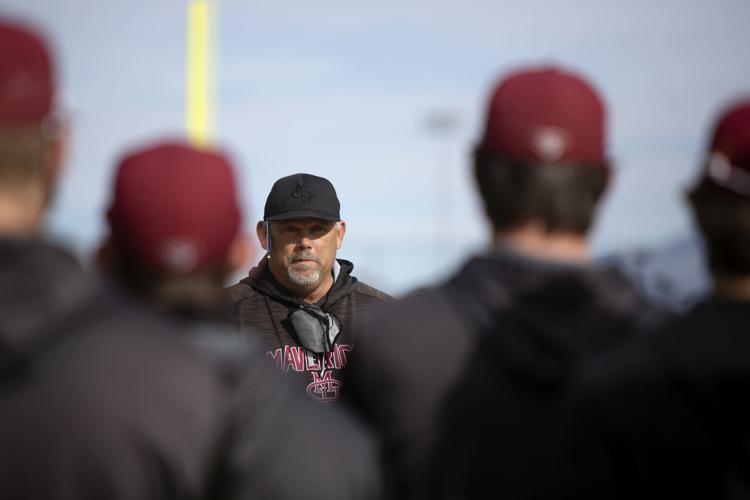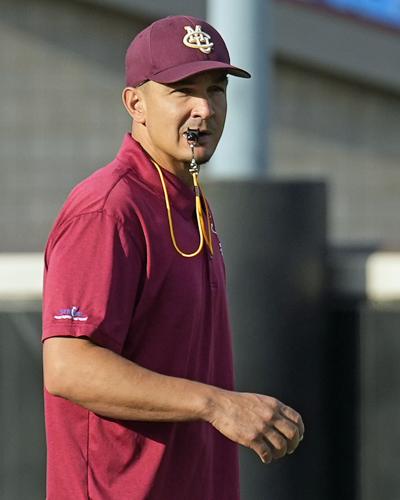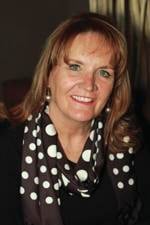Chris Hanks distinctly remembers the recruitment of Sergio Romo.
“It was the summer of ‘04, we had about four scholarships at that time, maybe 4 1/2,” the Colorado Mesa baseball coach said. “We had a chance to get Sergio, and the recruiting was two phone calls. The second one, it was one of the only times I felt like a used-car salesman. ‘Sergio, what do we gotta do to get you into a Maverick uniform?’
“He said, ‘Coach, if you pay for my tuition, I’ll come.’ I was like, ‘Done. I’ll pay your tuition.’ (Romo replied) ‘I’m coming to Mesa.’ ’’
There was a problem, though.
“I got off the phone and said, ‘Holy crap, I gotta go raise some money,’ ’’ Hanks said, laughing.
He’d already awarded all of the scholarship money in his budget. Knowing it was only a one-year commitment — Romo was leaving North Alabama for his senior year — Hanks raised enough money to cover Romo’s tuition and books, one of the largest scholarships he’d ever awarded, to the future three-time World Series champion pitcher for the San Francisco Giants.
Last spring, the university announced that Bryan Rooks, who had been CMU’s athletic director since 2017, would become the senior director of athletic giving, focusing solely on raising money to build an endowment that would eventually allow all 26 programs at CMU to award the full equivalent of scholarships allowed at NCAA Division II level.
It will put an end to coaches having to balance awards with what’s in the budget. Instead of paying a certain amount of money toward the student-athlete’s educational bill, making sure they stay on budget and under their NCAA limit, a coach can award a percentage of a full scholarship, whether that’s a third, a quarter, a half, etc., with their final total needing only to match the NCAA’s allotment. The endowment pays the bill, whether it’s for in-state or out-of-state tuition or how many credit hours are taken.
“That’s where this new program comes in,” swimming and diving coach Mickey Wender said. “That’s a conversation, and it’s sort of a negotiation and an agreement, an understanding that we make with an athlete and their family: What do you need?
“To use the Ben Sampson example, when he went from unranked and a non-qualifier (for nationals) to runner-up nationally and a major player, the conversation with his family is, what do you need? I’d be shocked if there was anybody at Colorado Mesa University that’s on a full scholarship. Nobody gets what they want, but what do you need?
“Our families and athletes have been so gracious and supportive and understanding and taking less than what they would get at many, many other institutions, Division I or Division II, so they can be a part of our program and help us win. Now we’ll be able to reward people for their contributions at a much, much higher level.”
First-year football coach Miles Kochevar knows that 36 scholarship equivalencies won’t take care of every player on his team of nearly 130, but it would put CMU on the same plane as many other schools in the conference and nation. Those scholarships are vital for him to build depth by recruiting the top Division II prospects from the high school ranks and not plugging as many gaps through the transfer portal with players for only one or two years.
“You know, OK, we’ve got to build this thing to sustain greatness,” Kochevar said. “Well, you’re looking at, where are we going to be in two years when these guys graduate? Are we going to have depth and truly be able to develop these guys? That’s the biggest thing, you want to take a crap-shoot year in and year out? I’m not saying you won’t get good teams, but if you don’t have the foundation built from within, from freshmen and guys who truly believe in what you’re doing and want to be a part of it, it’s gonna be hard to be the culture excellence you want to have.
“Then, you’re not living what the true Division II experience is of being able to come in and get an education, build a foundation and network off of for when football does quit you. It quits everyone someday and they’re hopefully going to rely back on those relationships and what they built while they were here at Colorado Mesa. That’s a big part.”
Despite being behind many of the teams they compete with on a week-to-week basis in scholarship levels, CMU’s teams have excelled at the Division II level, although the school has not yet won an NCAA national team championship.
All eight winter sports teams competed in the national playoffs last season, the only Division II school to achieve that level of success, and of the 26 programs, 19 reached at least the regional level of the national playoffs in the 2021-22 school year.
The beach volleyball team, not yet an NCAA-sanctioned sport, won the American Volleyball Coaches Association national title last spring, and the baseball team has the highest winning percentage in the nation since 2017, with two national runner-up finishes since 2014.
Men’s wrestling, track and field and swimming and diving have broken through with individual national champions and teams are climbing in the national polls and standings every year.
With more scholarships to help the 35 student-athletes on each the men’s and women’s swimming and diving team, Wender said the Mavericks could “be perennial contenders for a national championship.”
“It helps to level the playing field a little bit,” Wender said. “I’ve been told we’re the only top 10 team nationally that isn’t fully funded. It’’ll be nice to be able to reward people for their contributions and be able to offer the same amount as Queens University or as Drury, Tampa or as Indianapolis, these top swimming programs in Division II. It’s going to be great to be able to say yeah, we can offer you the same amount.”
CMU’s facilities, location, campus and academic reputation are big selling points in recruiting, helping to make up for smaller scholarship awards.
“It’s a major public institution, so you get all the benefits, which is pretty unusual in Division II,” Wender said. “Mostly these are small, private schools (among swimming powers), so we have a great advantage in being a major public institution, over 10,000 students and over 100 different majors. We can offer an experience many of these private schools can’t.”
A program that’s waiting to officially join the NCAA, women’s wrestling, has roughly 1.7 scholarships to award, far behind the 10 allowed. The sport, which will be sanctioned in the 2023-24 season, competes under the umbrella of the National Wrestling Coaches Association and placed fifth in the National Collegiate Women’s Wrestling Championships last season.
Coach Travis Mercado doesn’t use limited scholarship resources as an excuse not to recruit the best wrestlers possible. He searches for outside scholarships, emphasizing their grades in high school, which opens up academic awards.
“The reality is, I don’t want to say creative, it’s not creative, but I’ve worked well with our financial aid office to help student-athletes who just missed out on the next tier of academic scholarships,” Mercado said. “OK, what do we need to do? Try to take the SAT or ACT again, you need to hammer it home the last semester of your senior year to get your GPA up .1 or .2, helping them find outside scholarships. I saw this scholarship, it’s for female student-athletes, you should apply for it.”
Most of the top programs in the nation, he said, have between 6-9 scholarships.
“I know what we’ve accomplished here now and I know what we can accomplish with what we have,” Mercado said. “Being able to have (full scholarships) will take a little bit off that recruiting stress. ... It would be tremendous. Every year I’m like, how am I going to divvy up the pot that we have and bring in the best girls?”
Colorado Mesa President John Marshall said when announcing the scholarship initiative that the goal is to make CMU the premier Division II athletic program in the nation.
“I think that level of commitment, that investment in this institution will be profound,” Wender said. “I think once you arm the coaches with that level of scholarship funding, it’s just going to be a competition who can get to the finish line first in terms of a national championship.”


















